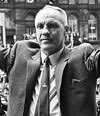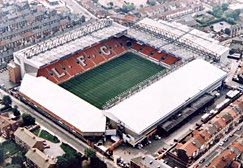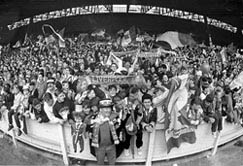
The most successful football club in British history. Liverpool FC are once again on the rise, with Houllier's team following in the footsteps of Shankly, Paisley and Dalglish' Anfield greats before them.
You can read here about the team of '89 who played at Hillsborough on that day in April, the club's honours list and a brief history of the legendary area, Anfield.
There are also extensive lists of links to other Liverpool sites.
The true independent voice of the ordinary supporter. We highlight Liverpool 'zine 'Through The Wind and Rain' - always a staunch supporter of the HJC and a voice that has kept alive and published articles on Hillsborough throuout the last 12 years.
The Hillsborough Justice Campaign
PO Box 1089
178 Walton Breck Road
Liverpool
L69 4WR
Tel / fax : 0151 2605262
email: hjcshop@tiscali.co.uk
Anfield - home of Liverpool Football Club

Anfield has become synonymous over the past 50 years with 'football' as the home of the world famous Liverpool Football Club and the name of its ground. Yet the Liverpool district, north of the city centre and set within a valley, has acquired many historical claims of its own since its early days as a tiny settlement.
Even the tale of the name Anfield and how it originated is quite a startling and little know fact. The story begins in the mid 18th century when Liverpool was a relatively small place. Prisoners who were to be hanged were taken to the top of London Road where one gibbet (the apparatus used to hang prisoners) stood.
Ascrime in Liverpool got worse the penal system decided that the gallows in London Road were not enough. A field not far from London Road at the top of what is now Sleepers Hill) that also had sturdy trees was chosen as another sit to hang prisoners. This place became known as Hangfield. During the late 18th century, when prisoners were no longer hanged there and people began to move into the area the sinister meaning of Hangfield was adapted and, before long the area became known as Anfield.

Another important historical event that took place in Anfield was the first aeronautical voyage in the world. In 1812, two Liverpool men, a father and son name James and Wyndham Sadler, pioneered the first successful balloon journey ever. Using gas from a local gas works to power the balloon they set off from an enclosure at the top of a hill (where Sleepers Hill and Walton Breck Road are today) and floated all the way to West Derby before slowly coming down. Over 94,000 people - which would then have been a significant proportion of Liverpool's population witnessed the event.
The local economy, based along Breck Road, has become a thriving retail tradition and there are many shops that offer a nostalgic ideal of the small shopkeeper. Unlike many areas that have seen the decline of the local butcher and green grocer, Breck Road still has shops that offer the customer a specific service.
Adapted from an article in Your Move magazine.
